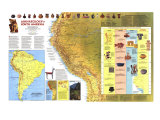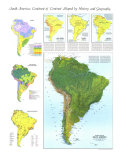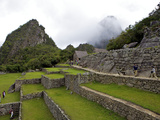The 1982 Indians of South America map features:
• An introduction entitled "Geography of Indian Culture"
• The continent colored to show the six Indian groups with individual tribes listed in their respective areas
• Information on the six Indian groups including Amazonia, Andes, Circum-Caribbean, East Brazil, Gran Chaco, and South
• Illustrations of the various peoples of the region
• Rivers noted on the map
* Lesson plan idea - have your students update the information and latest statistics concerning the indigineous populations in the Americas; discuss the political, economic, and environmental situations that are current for the region. • maps
GEOGRAPHY OF INDIAN CULTURE
PERHAPS 200 centuries before Balboa stood atop a rise in Panama looking out across the margin of a great, then peaceful ocean, bands of humans were for the first time filtering south across the same ground–the isthmus that joins the two American continents. Their forebears had peopled the north; their progeny would people the south.
These Paleo-Indians were hunter-gatherers, and in any generation the scope of their migration was dictated by the necessity to follow game and exploit new sources of edible plants. As they progressd into the continent, their adaptation to varying terrain, climate, vegetation, and fauna shaped their cultures.
How quickly and to what extent Paleo-Indians peopled South America is not clear. Evidence suggests settlement in the central Andes 20,000 years ago, Caribbean coast 13,000, Patagonia 12,500, western Brazil 12,000, and eastern Brazil 10,000.
It appears, however, that between 18,000 and 13,000 years ago and again between 4,000 and 2,000 years ago, a much drier climate reduced Amazonian forests to scattered refuges. During those periods, migration of various groups may have been easier and may help account for the varied languages spoken there.
As shown on the map, Indian groups can be divided broadly into six regions, based on both geography and cultural variations. Names, locations and customs of selected groups are shown as they were when contacted by non-Indians–over a period that has spanned nearly 500 years.
Since first contact, Indian groups have been decimated, and worse, by force of arms or by introduced diseases such as measles and smallpox. Those groups with the highest civilizations or with homelands most accessible from the coasts were ravaged first. Others more remote were affected by the implements of European culture through networks of trade long before they saw their first non-Indians. A large percentage of the Indian population has been absorbed into today's society.
The continent was first a New World for Paleo-Indians and their Indian descendants who lived with Andean snows and Amazonian rains, Patagonian emptiness and the unrelenting winds of Tierra del Fuego. Then, in the name of religion and gold proclaimed in blood, the continent became a New World again. The anthropologist Claude Levi-Strauss has written that “for us European earth-dwellers, the adventure played out in the heart of the New World signifies in the first place that it was not our world and that we bear responsibility for the crime of its destruction; and secondly, that there will never be another New World ...”
CIRCUM-CARIBBEAN
An arc beginning in southern Central America, then running across the northern sectors of modern Colombia and Venezuela, and containing from Trinidad to Cuba and the Bahamas supported a diverse group of Indian societies before Europeans arrived. Some had advanced cultures. Though not as complex as those of the Inca and Maya, they were nevertheless based on intensive agriculture, substantial villages, and elaborate religions, and were organized politically into chiefdoms.
AMAZONIA
Despite its thick crown of trees, most of the tropical forest grows in easily exhausted soil unsuitable for many crops. Rivers and streams support abundant fish, and in places, turtles and shellfish. Game includes monkeys, birds, rodents, peccaries, and tapirs. The hot climate varies little. Indian groups tended to be small, 50 to 150, living in pole-and-thatch houses. They cultivated plants such as manioc, a tuber, in soil prepared by cutting and burning small forest plots that were abandoned after a few years. Fish were taken by traps, arrows, and poisons. Game was hunted with bow and arrow or curare-tipped missiles fired from blowguns. communication and trade were mostly by canoes along river systems.
EAST BRAZIL - From the forests of the Mato Grosso to the arid highlands that separate the southern Amazon basin from the Atlantic coast, many Indians spoke dialects of the Ge language family, and were, at first contact, distinguished by three traits: They were seminomadic hunter-gatherers with little agriculture; they did not use canoes but traveled overland, sometimes on established trails; and each village was divided into complex groupings by sex, kinship, and age. The men ranged across the savanna with bow and arrow, hunting peccaries for meat and birds for their decorative plumage. When whites introduced cattle ranching and overhunted with firearms, they greatly reduced the available game and forced many Indians into reliance on subsistence farming.
ANDES - The nova of Inca Empire flashed on and was snuffed out within a century, yet the brilliance of its culture was no sudden illumination. For thousands of years Andean societies had been developing those practices that collectively make a civilization. Among them were religion, pottery, weaving, civil engineering, metallurgy, and monumental architecture. But farming was first.
Bounded by arid coastline on the west and dense jungle inhabited by hostile groups on the Andes' eastern slopes, fertile intermountain valleys offered secure and productive farming areas. By 2,500 years ago Andeans were cultivating potatoes, gourds, cotton, squash, beans, chili peppers, maize, avocados, and peanuts. They learned to use fertilizer and to irrigate and terrace slopes. Such farming created food surpluses, concentrated populations, and permitted specialized occupations. The palaces of stone, royal roads, and altars of gold sprang from handfuls of seed and running water.
SOUTH - The farmers of the southern Andean highlands and coast, the hunters of Patagonia and Tierra del Fuego, and the shellfish gatherers of the southwest coast exploited their environments successfully in pre-Columbian times. Yet only the farming Mapuches, who had resisted the Incas, could defend themselves against the Europeans. The hunter-gatherer societies, simpler, with fewer members, and in harsher terrain had no margin for disruption, and all perished.
GRAN CHACO - Hot and dry, yet swampy during rainy-season flooding of intermittent rivers, the interior plain called Gran Chaco and nicknamed “green hell” was home to bands of hunters whose means os subsistence had changed little from those of their Paleo-Indian ancestors. Adept at guerrilla warfare, they resisted Spanish control, becoming more effective as they mastered horsemanship on animals taken from their white enemies. But their fate paralleled that of the Indians of the North American plains. They could not prevail against settlers bringing with them armed troops, nor against something even worse – smallpox.



















